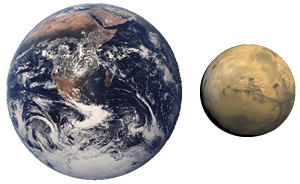Gravitational fields - Multiple Choice Q1 Masses of M and 2M exert a gravitational force F on each other when the distance between their centres is r. What is the gravitational force between masses of 2M and 4M when the distance between their centres is 4r?
Q2 A planet has a radius half the Earth's radius and a mass a quarter of the Earth's mass. What is the approximate gravitational field strength on the surface of the planet?
Q3. At the surface of the Earth:
The radius of the Earth is R. An object, whose weight on the surface of the Earth is W, is moved to a height 3R above the surface. Which line, A to D, in the table gives the weight of the object and the gravitational potential at this height?
Q4. A satellite of mass m travels in a circular orbit of radius r around a planet of mass M. Which one of the following expressions gives the angular speed of the satellite?
Q5. Which one of the following has different units to the other three?
Q6. The diagram shows two objects of equal mass m separated by a distance r.
Which line, A to D, in the table gives the correct values of the gravitational field strength and gravitational potential at the mid-point P between the two objects?
Q7. Mars has a diameter approximately 0.5 that of the Earth, and a mass of 0.1 that of the Earth.
If the gravitational potential at the Earth’s surface is –63 MJ kg–1, what is the approximate value of the gravitational potential at the surface of Mars?
Q8. A small mass is situated at a point on a line joining two large masses ml and m2 such that it experiences no resultant gravitational force. If its distance from the mass m1 is r1 and its distance from the mass m2 is r2, what is the value of the ratio ?
Q9. A projectile moves in a gravitational field. Which one of the following is a correct statement for the gravitational force acting on the projectile?
Q10. The diagram shows two positions, X and Y, at different heights on the surface of the Earth.
Which line, A to D, in the table gives correct comparisons at X and Y for gravitational potential and angular velocity?
|
Follow me...
|








